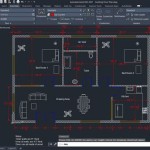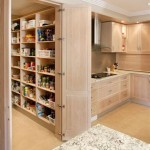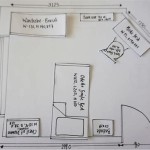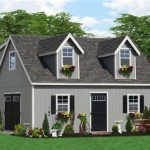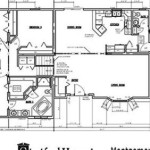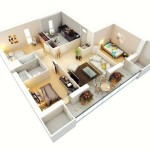
An energy efficient house floor plan is a design that prioritizes the efficient use of energy to reduce the environmental impact and operating costs of a home. This is achieved through the strategic placement of windows, doors, and other architectural elements to maximize natural light, ventilation, and insulation. For example, a well-planned floor plan may position the living room on the south side of the house to take advantage of passive solar heating during the winter months.
By incorporating energy-efficient principles into the floor plan, homeowners can reduce their energy consumption and create a more comfortable and healthier living environment. Not only does this result in lower utility bills, but it also contributes to a more sustainable lifestyle and a reduced carbon footprint.
In this article, we will explore the key elements of an energy-efficient house floor plan and provide practical tips for homeowners who are looking to incorporate these principles into their own homes.
An energy-efficient house floor plan incorporates several key elements to reduce energy consumption and create a more comfortable and sustainable living environment. These include:
- Passive solar design
- Natural ventilation
- Energy-efficient windows
- Insulation
- Air sealing
- LED lighting
- Energy-efficient appliances
- Smart home technology
By incorporating these elements into the floor plan, homeowners can create a home that is more comfortable, energy-efficient, and sustainable.
Passive solar design
Passive solar design is a building technique that uses the sun’s energy to heat and cool a home. This is achieved through the strategic placement of windows, doors, and other architectural elements to maximize solar gain in the winter and minimize it in the summer. For example, a well-planned passive solar home will have large windows facing south to allow sunlight to enter during the winter months, when the sun is lower in the sky. In the summer, overhangs or awnings can be used to shade these windows and prevent the home from overheating.
Passive solar design can be used to reduce a home’s energy consumption by up to 50%. In addition to saving money on energy bills, passive solar homes are also more comfortable to live in. They are naturally warmer in the winter and cooler in the summer, which can reduce the risk of health problems such as respiratory infections and heat stroke.
There are a number of different passive solar design strategies that can be used to create an energy-efficient home. Some of the most common strategies include:
- Direct gain: This strategy uses large windows to allow sunlight to enter the home and heat the interior. The heat is then stored in the thermal mass of the home, such as the concrete slab or brick walls.
- Indirect gain: This strategy uses a sunspace or Trombe wall to collect solar energy and then release it into the home. A sunspace is a room with a south-facing wall that is made of glass. The Trombe wall is a concrete or brick wall that is painted black and placed behind the glass. The sunspace heats up during the day and the heat is then transferred to the Trombe wall. The Trombe wall then releases the heat into the home at night.
Passive solar design is a cost-effective and sustainable way to reduce a home’s energy consumption and create a more comfortable living environment.
Natural ventilation
Natural ventilation is the process of using outdoor air to cool and ventilate a building. This can be achieved through the use of windows, doors, and other openings in the building envelope. Natural ventilation can help to reduce a home’s energy consumption by reducing the need for mechanical cooling and ventilation systems.
- Cross ventilation: This is the process of using two or more openings in a building to create a flow of air. Cross ventilation can be used to cool a home in the summer and to ventilate it in the winter. To achieve cross ventilation, open windows and doors on opposite sides of the house. This will create a flow of air that will help to cool the house and remove stale air.
- Stack ventilation: This is the process of using the difference in temperature between the inside and outside of a building to create a flow of air. Stack ventilation can be used to ventilate a home in the winter and to cool it in the summer. To achieve stack ventilation, open windows and doors at the top and bottom of the house. This will create a flow of air that will help to ventilate the house and remove stale air.
- Passive downdraft cooling: This is a type of natural ventilation that uses the weight of cool air to create a flow of air. Passive downdraft cooling can be used to cool a home in the summer. To achieve passive downdraft cooling, open windows and doors at the bottom of the house and close them at the top. This will create a flow of cool air that will help to cool the house.
- Wind towers: These are towers that are used to capture the wind and direct it into a building. Wind towers can be used to ventilate a home in the summer and to cool it in the winter. To achieve wind tower cooling, open windows and doors at the bottom of the wind tower and close them at the top. This will create a flow of air that will help to ventilate the house and remove stale air.
Natural ventilation is a cost-effective and sustainable way to reduce a home’s energy consumption and create a more comfortable living environment.
Energy-efficient windows
Energy-efficient windows are an important part of an energy-efficient house floor plan. They can help to reduce heat loss in the winter and heat gain in the summer, which can lead to significant energy savings. In addition, energy-efficient windows can help to improve the comfort of your home by reducing drafts and providing a more even temperature distribution.
There are a number of different factors to consider when choosing energy-efficient windows, including the type of glass, the frame material, and the installation method. The most important factor is the type of glass. Energy-efficient windows typically use double- or triple-glazed glass, which has a layer of inert gas between the panes of glass. This helps to reduce heat transfer and improve insulation.
The frame material is also important. Energy-efficient windows can be made from a variety of materials, including wood, vinyl, and aluminum. Wood frames are a good choice for energy efficiency because they are a natural insulator. Vinyl frames are also a good choice because they are durable and weather-resistant. Aluminum frames are not as energy-efficient as wood or vinyl, but they are more affordable.
The installation method is also important. Energy-efficient windows should be installed properly to ensure that they are airtight and weather-tight. This will help to prevent heat loss and heat gain. Improperly installed windows can also lead to drafts and other problems.
By choosing energy-efficient windows and having them installed properly, you can improve the comfort of your home and save money on energy bills.
Insulation
Insulation is an important part of an energy-efficient house floor plan. It helps to keep the heat in during the winter and the heat out during the summer, which can lead to significant energy savings. In addition, insulation can help to improve the comfort of your home by reducing drafts and providing a more even temperature distribution.
There are a number of different types of insulation available, each with its own advantages and disadvantages. Some of the most common types of insulation include:
- Fiberglass insulation: This is the most common type of insulation used in homes. It is made from glass fibers that are spun into a mat or blanket. Fiberglass insulation is relatively inexpensive and easy to install, but it is not as effective as some other types of insulation.
- Cellulose insulation: This type of insulation is made from recycled paper products. It is a good choice for people who are looking for an environmentally friendly option. Cellulose insulation is also relatively inexpensive and easy to install, but it is not as effective as some other types of insulation.
- Spray foam insulation: This type of insulation is made from a polyurethane foam that is sprayed into place. Spray foam insulation is very effective at insulating, but it is also more expensive than other types of insulation.
- Rigid foam insulation: This type of insulation is made from a polystyrene foam that is cut into boards. Rigid foam insulation is very effective at insulating, but it is also more expensive than other types of insulation.
The type of insulation that you choose will depend on your budget, your needs, and the climate in your area. It is important to consult with a qualified contractor to determine the best type of insulation for your home.
Insulation is an important part of an energy-efficient house floor plan. By choosing the right type of insulation and having it installed properly, you can improve the comfort of your home and save money on energy bills.
Air sealing
Air sealing is the process of sealing up any cracks or gaps in a building envelope to prevent air from leaking in or out. This is important for energy efficiency because it helps to keep the conditioned air inside the home, which reduces the need for heating and cooling. In addition, air sealing can help to improve the comfort of your home by reducing drafts and providing a more even temperature distribution.
- Sealing around windows and doors: This is one of the most important areas to air seal, as windows and doors are often the source of air leaks. Use caulk or weatherstripping to seal any gaps around the frames of windows and doors.
- Sealing around pipes and wires: Pipes and wires can also be a source of air leaks. Use caulk or expanding foam to seal any gaps around pipes and wires where they enter the home.
- Sealing around chimneys and vents: Chimneys and vents can also be a source of air leaks. Use caulk or metal flashing to seal any gaps around chimneys and vents.
- Sealing the attic: The attic is often a major source of air leaks. Use caulk or weatherstripping to seal any gaps around the attic hatch and any other openings in the attic.
Air sealing is an important part of an energy-efficient house floor plan. By sealing up any cracks or gaps in the building envelope, you can improve the comfort of your home and save money on energy bills.
LED lighting
LED (light-emitting diode) lighting is a type of lighting that uses light-emitting diodes to produce light. LEDs are small, energy-efficient, and long-lasting, making them an ideal choice for energy-efficient house floor plans.
- Energy efficiency: LEDs are much more energy-efficient than traditional incandescent and fluorescent lighting. They use up to 80% less energy than incandescent bulbs and up to 50% less energy than fluorescent bulbs. This can lead to significant savings on energy bills.
- Long lifespan: LEDs have a much longer lifespan than traditional lighting. They can last up to 50,000 hours, which is more than 50 times longer than incandescent bulbs and 25 times longer than fluorescent bulbs. This means that you will not have to replace LED bulbs as often, which can save you money in the long run.
- Durability: LEDs are more durable than traditional lighting. They are not as susceptible to damage from vibration or shock, making them ideal for use in areas where traditional lighting may be more likely to break.
- Compact size: LEDs are very compact, which makes them ideal for use in small spaces or in fixtures where space is limited.
LED lighting is a great choice for energy-efficient house floor plans. They are energy-efficient, long-lasting, durable, and compact. By using LED lighting, you can save money on energy bills, reduce the need for maintenance, and create a more sustainable home.
Energy-efficient appliances
Energy-efficient appliances are an important part of an energy-efficient house floor plan. They use less energy to operate than traditional appliances, which can lead to significant savings on energy bills. In addition, energy-efficient appliances can help to reduce greenhouse gas emissions and create a more sustainable home.
There are a number of different types of energy-efficient appliances available, including refrigerators, dishwashers, washing machines, and dryers. When choosing energy-efficient appliances, it is important to look for the Energy Star label. Energy Star is a government-backed program that helps consumers identify energy-efficient products. Appliances that have the Energy Star label meet strict energy efficiency standards set by the government.
In addition to looking for the Energy Star label, there are a number of other things to consider when choosing energy-efficient appliances. These include:
- Size: The size of the appliance is important. A larger appliance will use more energy than a smaller appliance. Choose an appliance that is the right size for your needs.
- Features: The features of the appliance can also affect its energy consumption. For example, a refrigerator with an ice maker will use more energy than a refrigerator without an ice maker. Only choose features that you need.
- Usage: How often you use the appliance will also affect its energy consumption. If you use an appliance frequently, it is important to choose an energy-efficient model.
By choosing energy-efficient appliances, you can save money on energy bills, reduce greenhouse gas emissions, and create a more sustainable home.
Smart home technology
Smart home technology can be used to improve the energy efficiency of a home in a number of ways. For example, smart thermostats can be programmed to learn your heating and cooling preferences and adjust the temperature accordingly. This can lead to significant energy savings, especially in homes that are heated or cooled inefficiently.
Smart lighting can also be used to save energy. Smart lights can be programmed to turn off automatically when they are not needed, and they can also be dimmed to reduce energy consumption. In addition, smart lights can be controlled remotely, which can be convenient and help to save energy.
Smart appliances can also be used to improve energy efficiency. For example, smart refrigerators can be programmed to adjust their temperature based on the amount of food inside. Smart washing machines can also be programmed to use less water and energy. In addition, smart appliances can be controlled remotely, which can be convenient and help to save energy.
By using smart home technology, homeowners can improve the energy efficiency of their homes and save money on energy bills. Smart home technology can also make homes more comfortable and convenient.
Here are some specific examples of how smart home technology can be used to improve the energy efficiency of a home:
- Smart thermostats can be programmed to learn your heating and cooling preferences and adjust the temperature accordingly. This can lead to significant energy savings, especially in homes that are heated or cooled inefficiently.
- Smart lighting can be programmed to turn off automatically when they are not needed, and they can also be dimmed to reduce energy consumption. In addition, smart lights can be controlled remotely, which can be convenient and help to save energy.
- Smart appliances can also be used to improve energy efficiency. For example, smart refrigerators can be programmed to adjust their temperature based on the amount of food inside. Smart washing machines can also be programmed to use less water and energy. In addition, smart appliances can be controlled remotely, which can be convenient and help to save energy.









Related Posts

